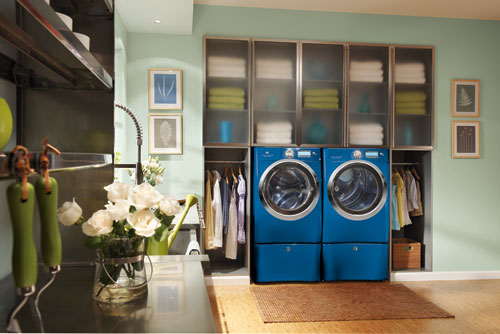Built-in Appliances: Combining Thoughtful Design Innovation with Superior Energy Performance
Clothes Washers
Hot water heating accounts for about 90 percent of the energy consumed by a clothes washer − only about 10 percent goes to the electricity to run the washer motor. Hence, specifications for washers should clearly address both energy and hot water usage. Further, most sources agree that consideration should be given to horizontal axis (H-axis) front loading washing machines. According to the Rocky Mountain Institute, "These use about half to a third of the energy of conventional vertical-axis top-loaders because they need less water to get the same load just as clean. They also have a faster spin speed than vertical axis machines, meaning that clothes will require less drying energy as a result. The energy, water, and detergent saved will cut annual washing costs by about $65, and pay back the higher up-front cost in three to nine years."
 |
Front-load washers can reduce energy, water and detergent with a savings of $65 per year. Front-load dryers can save about 10 percent with temperature-sensing controls. Photo courtesy of Electrolux ICON® |
Â
Additional considerations for specification features and options that affect the amount of hot water used and the overall efficiency of a clothes washer include:
- ENERGY STAR rating. First and foremost, specify a model that meets or exceeds the ENERGY STAR rating requirement for both energy and water usage.
- Wash and rinse cycles. Select a model with many choices. Warm wash cycles clean very well. Only oily stains may require hot washes. Depending on the clothes and local water quality (hardness), many homeowners can effectively do laundry exclusively with cold water, using cold water laundry detergents. Switching to cold water can save the average household more than $40 annually with an electric water heater and more than $30 annually with a gas water heater.
- Water level controls. Generally, washing a full load is most efficient and is capable of saving more than 3,400 gallons of water each year. Nonetheless, controls should allow the option of using a smaller amount of water for small loads when needed.
- Water extraction. Higher spin speeds in washing machines will reduce drying times.
Other Appliances
Beyond the appliances already discussed, there are other general appliances that fit into designs and need some attention.
Clothes Dryers
The fundamental specification choice in clothes dryers is to select between electric and gas-fired models. In terms of comparative energy use, gas dryers are generally less expensive to operate. Most sources agree, however, that there is not a lot of variation in overall energy use between models for identical loads run for identical times. The main variables for determining the amount of energy used in dryers become the frequency of usage and the running time selected when they are used.
Beyond fuel type, controls for turning off dryers become the major specification consideration for energy consumption. The first choice is whether or not the dryer uses sensors to automatically turn off the dryer once clothes are dry. The alternative is timed drying, leaving the running time, and corresponding energy use, to the guesswork of the user. The best dryers have moisture sensors inside the drum for sensing dryness and turning off the machine. Most others only infer dryness by using temperature sensors in the exhaust air portion of the dryer, which may result in running the dryer longer than needed. Compared with timed drying, savings of about 10 percent are possible with temperature-sensing controls and 15 percent with moisture-sensing controls.
One of the easiest things that a user can do to increase drying efficiency is to clean the lint trap before each and every load. Therefore, specifying a dryer that makes this a convenient and easy process is significant. Note that the ENERGY STAR program currently does not rate clothes dryers, so the specifications should not reference it.
Conclusion
Finding ways to reduce energy use and minimize the impact on the environment are among the goals of all green building efforts, including emerging residential green buildings. Paying attention to the specifications for residential appliances that require either less energy or less water or both to operate can contribute significantly to meeting those goals. There are many resources available to help architects design and specify appliances including those listed below:
Green Design and Energy Saving Resources for Residential Appliances
- ENERGY STAR is a government-backed program helping businesses and individuals protect the environment through superior energy efficiency. ENERGY STAR program information and rated appliance models are found at www.energystar.gov
- U.S. Green Building Council (USGBC) and Leadership in Energy and Environmental Design (LEED) Standards are found at www.usgbc.org
- National Association of Homebuilders (NAHB) represents residential builders nationwide. www.nahb.org
- Enterprise Foundation and information on the Green Communities Initiative. www.enterprisefoundation.org
- American Council for an Energy-Efficient Economy (ACEEE) is a nonprofit organization dedicated to advancing energy efficiency and promoting economic prosperity and environmental protection. www.aceee.org
- Association of Home Appliance Manufacturers (AHAM) provides market industry trends on appliances. www.aham.org
- Appliance Recycling Information Center (ARIC) provides information on recycling appliances. www.aham.org/aric
- Consumer Reports' rates appliances. www.ConsumerReports.org
- Rocky Mountain Institute addresses energy and consumer issues. www.rmi.org
- The Green Guide is a GreenBiz news affiliate. www.thegreenguide.com
- Greenbuilder.com is an online resource with information about building and appliances. www.greenbuilder.com
Â
| Recognized throughout Europe as the gold standard of appliances, Electrolux appliances have been used in fine European homes and restaurants for more than 80 years. With 120 designers at six design centers on five continents, Electrolux appliances feature a truly unique design and quality that have set the standard in the appliance industry. To learn more about Electrolux ICON®, please visit electroluxicon.com |








